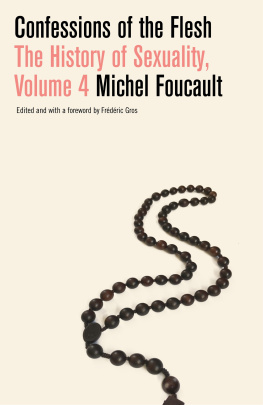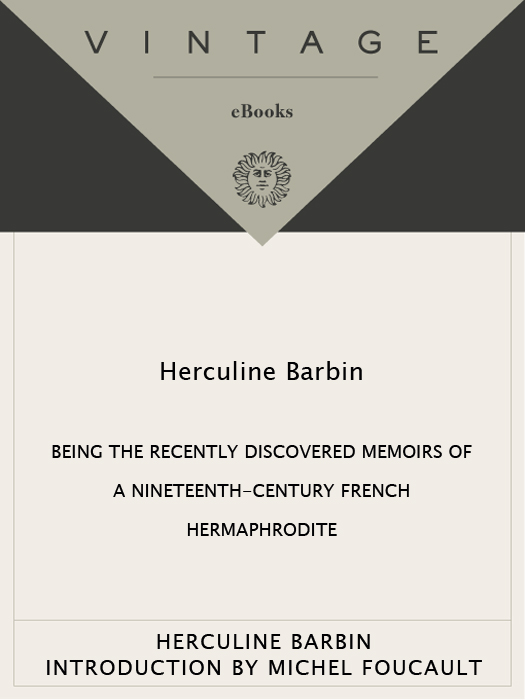Also by Michel Foucault
Madness and Civilization: A History of Insanity in the Age of Reason
The Order of Things: An Archaeology of the Human Sciences
The Archaeology of Knowledge (and The Discourse on Language)
The Birth of the Clinic: An Archaeology of Medical Perception
I, Pierre Rivire, having slaughtered my mother, my sister, and my brother A Case of Parricide in the Nineteenth Century
Discipline and Punish: The Birth of the Prison
The History of Sexuality, Volumes 1, 2, and 3
Power/Knowledge: Selected Interviews and Other Writings, 19721977
The Foucault Reader (edited by Paul Rabinow)

Vintage Books Edition, November 2010
Introduction copyright 1980 by Michel FoucaultTranslation of Introduction, Memoirs, Dossiercopyright 1980 by Richard McDougallTranslation of Ein Skandalser Fall copyright 1980 byRandom House, Inc.
All rights reserved. Published in the United States by Vintage Books, a division of Random House, Inc., New York, and in Canada by Random House of Canada Limited, Toronto. Originally published in France as Herculine Barbin, dite Alexina B. by Gallimard.
Copyright 1978 by Editions Gallimard. Published in hardcover in the United States by Pantheon Books, a division of Random House, Inc., New York.
Vintage and colophon are registered trademarks of Random House, Inc.
The Library of Congress has cataloged the Pantheon edition as follows:
Barbin, Herculine, 1838
Herculine Barbin: being the recently discovered memoirs of a nineteenth-century French hermaphrodite.
Translation of Herculine Barbin, dite Alexina B.
1. HermaphroditismBiography. 2. Barbin, Herculine, 1838
RC 883. B 3713 616.69400924 [ B ] 793304
eISBN: 978-0-307-83309-9
www.vintagebooks.com

v3.1
 CONTENTS
CONTENTS



A SCANDAL AT THE CONVENT
by Oscar Panizza
A story based on the life of Herculine Barbin
 INTRODUCTION
INTRODUCTION
Do we truly need a true sex? With a persistence that borders on stubbornness, modern Western societies have answered in the affirmative. They have obstinately brought into play this question of a true sex in an order of things where one might have imagined that all that counted was the reality of the body and the intensity of its pleasures.
For a long time, however, such a demand was not made, as is proven by the history of the status which medicine and law have granted to hermaphrodites. Indeed it was a very long time before the postulate that a hermaphrodite must have a sexa single, a true sexwas formulated. For centuries, it was quite simply agreed that hermaphrodites had two. Were they terror-inspiring monsters, calling for legal tortures? In fact, things were much more complicated. It is true that there is evidence of a number of executions, both in ancient times and in the Middle Ages. But there is also an abundance of court decisions of a completely different type. In the Middle Ages, the rules of both canon and civil law were very clear on this point: the designation hermaphrodite was given to those in whom the two sexes were juxtaposed, in proportions that might be variable. In these cases, it was the role of the father or the godfather (thus of those who named the child) to determine at the time of baptism which sex was going to be retained. If necessary, one was advised to choose the sex that seemed to have the better of the other, being the most vigorous or the warmest. But later, on the threshold of adulthood, when the time came for them to marry, hermaphrodites were free to decide for themselves if they wished to go on being of the sex which had been assigned to them, or if they preferred the other. The only imperative was that they should not change it again but keep the sex they had then declared until the end of their lives, under pain of being labeled sodomites. Changes of option, not the anatomical mixture of the sexes, were what gave rise to most of the condemnations of hermaphrodites in the records that survive in France for the period of the Middle Ages and the Renaissance.
Biological theories of sexuality, juridical conceptions of the individual, forms of administrative control in modern nations, led little by little to rejecting the idea of a mixture of the two sexes in a single body, and consequently to limiting the free choice of indeterminate individuals. Henceforth, everybody was to have one and only one sex. Everybody was to have his or her primary, profound, determined and determining sexual identity; as for the elements of the other sex that might appear, they could only be accidental, superficial, or even quite simply illusory. From the medical point of view, this meant that when confronted with a hermaphrodite, the doctor was no longer concerned with recognizing the presence of the two sexes, juxtaposed or intermingled, or with knowing which of the two prevailed over the other, but rather with deciphering the true sex that was hidden beneath ambiguous appearances. He had, as it were, to strip the body of its anatomical deceptions and discover the one true sex behind organs that might have put on the forms of the opposite sex. For someone who knew how to observe and to conduct an examination, these mixtures of sex were no more than disguises of nature: hermaphrodites were always pseudo-hermaphrodites. Such, at least, was the thesis that tended to gain credence in the eighteenth century, through a certain number of important and passionately argued cases.
From the legal point of view, this obviously implied the disappearance of free choice. It was no longer up to the individual to decide which sex he wished to belong to, juridically or socially. Rather, it was up to the expert to say which sex nature had chosen for him and to which society must consequently ask him to adhere. The law, if it was necessary to appeal to it (as when, for example, someone was suspected of not living under his true sex or of having improperly married), had to establish or reestablish the legitimacy of a sexual constitution that had not been sufficiently well recognized. But if nature, through its fantasies or accidents, might deceive the observer and hide the true sex for a time, individuals might also very well be suspected of dissembling their inmost knowledge of their true sex and of profiting from certain anatomical oddities in order to make use of their bodies as if they belonged to the other sex. In short, the phantasmagorias of nature might be of service to licentious behavior, hence the
















